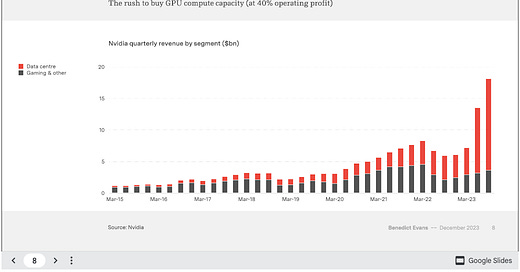🎲 The rush to buy GPU compute capacity
AI data and trends for business leaders | AI systems series
The demand for GPU compute capacity has surged due to a confluence of factors. From the booming popularity of cryptocurrency mining, which relies on GPUs for calculations, to advancements in AI and machine learning that leverage GPUs for faster training, various sectors are vying for limited resources.
This has created a rush to acquire GPUs, often leading to stock shortages and inflated prices. Gamers and researchers alike are left competing for these powerful chips, highlighting the critical role GPUs play in our increasingly data-driven world.
📌 Fact 1: a perfect storm
The rush for GPUs can be attributed to a perfect storm of increased demand from several sectors, all needing the raw processing power GPUs offer:
1. Gamers: This is a traditional driver of GPU demand. Gamers crave the best possible performance for smooth, high-resolution gameplay, especially with features like ray tracing. New game releases often trigger buying sprees as players upgrade their hardware.
2. Cryptocurrency mining: Some cryptocurrencies, like Ethereum, rely on a Proof-of-Work system where miners compete by solving complex mathematical problems. GPUs excel at these tasks, leading to miners snapping up large quantities of GPUs to build powerful mining rigs. This can significantly impact availability for gamers.
3. Artificial Intelligence and Machine Learning: The rise of AI and machine learning has created a massive need for powerful compute capacity. GPUs, due to their parallel processing architecture, are particularly adept at accelerating these tasks. Researchers and companies heavily invested in AI development often require large GPUs to train complex models, further straining supply.
4. Content creators: Professionals in video editing, 3D animation, and other demanding creative fields rely on GPUs for faster rendering and smoother workflows. As software and project complexities increase, these creators require more powerful GPUs, adding to the overall demand.
📌 Fact 2: the impact
This confluence of factors creates a situation where multiple groups compete for a limited supply of GPUs. This competition often leads to:
Stock shortages: Manufacturers struggle to keep pace with the high demand, leading to empty shelves and frustrated buyers.
Price inflation: With limited supply and high demand, prices can skyrocket, making it difficult for everyone to access the latest GPUs.
Overall, the rush for GPUs highlights their growing importance in various fields beyond gaming. However, it also creates challenges for all involved, with gamers, researchers, and content creators alike feeling the pinch of limited availability and inflated prices.
📌 Fact 3: GPU advancements and prices
Advancements: GPUs constantly evolve, with new generations offering significant improvements over previous ones. Here are some key advancements:
More transistors: GPUs are packing more transistors, allowing for faster processing of complex graphics and computations.
Improved architecture: New architectures optimize how data flows within the GPU, boosting performance and efficiency.
Ray tracing: This technology simulates light behavior for ultra-realistic graphics but requires powerful GPUs.
AI capabilities: GPUs are increasingly used for machine learning and artificial intelligence, with features to accelerate these tasks.
Prices: GPU prices can be volatile. While advancements generally lead to more powerful GPUs, the cost can fluctuate due to:
Supply and demand: High demand from gamers and cryptocurrency miners can drive up prices.
Manufacturing costs: The complex process of making GPUs can be expensive.
New product launches: Prices may adjust as new generations hit the market.
Importance of GPUs: GPUs play a crucial role in various fields:
Gaming: A powerful GPU is essential for smooth, high-resolution gameplay with advanced features like ray tracing.
Graphic design and animation: GPUs accelerate tasks like rendering complex 3D models and video editing.
Scientific computing: GPUs are used for simulations, data analysis, and other scientific applications requiring high processing power.
Machine learning and AI: GPUs are well-suited for training machine learning models and performing AI tasks.
GPUs are constantly improving at handling demanding graphics and computations, making them essential for various applications.
However, pricing can be a challenge due to market fluctuations.

Resources
Continue exploring
Workbook training: Introduction to the data transformation era, part 1
Hello, This part of the training relates to part 1 of the workbook: "Introduction to the data transformation era." You can read it here. Why this training and how it was conceived Traditional methods advocate a series of sequences of various activities, from specifications to system validation, according to a pre-established schedule.
🎲 Data and trends
This email is sent to you because you signed up for Wild Intelligence by Yael Rozencwajg. Thank you for your interest in our newsletter!
Data and trends are part of Wild Intelligence, as well as its approaches and strategies.
We share tips to help you lead, launch, and grow your sustainable enterprise.
Become a premium member, and get our tools to start building your AI-based enterprise.




